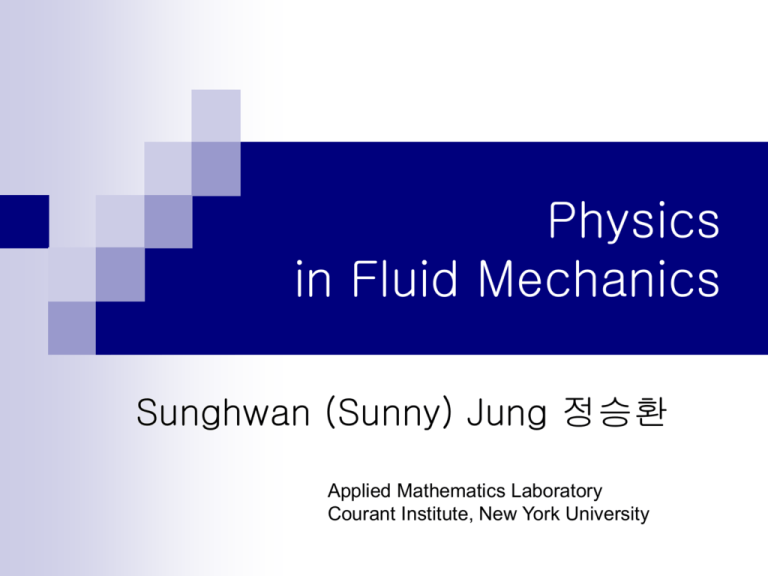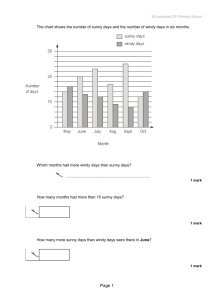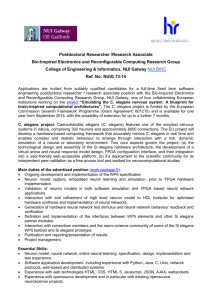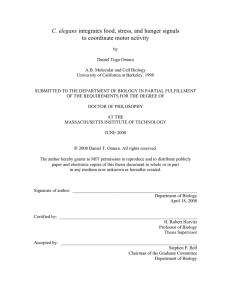Talk_Postech - Courant Institute of Mathematical Sciences
advertisement

Physics in Fluid Mechanics Sunghwan (Sunny) Jung 정승환 Applied Mathematics Laboratory Courant Institute, New York University Surface waves on a semi-toroidal ring Sunghwan (Sunny) Jung Erica Kim Michael Shelley Motivation Faraday (1831) - wave formation due to vibration Benjamin & Ursell (1954) - stability analysis Vibrating a pool Vibrating a bead Vertically vibrated Vertically vibrated Other geometries of the water surface Quasi-one dimensional surface wave Hydrophobic Materials 4 mm 1 mm HydrophobicSurface Surface Hydrophobic Contact Angle ~ 150 O Glass Surface Hydrophobic Surface Experimental Setup Hydrophobic surfaces Glass 1 cm Speaker 3 cm 3 cm 1 cm 3 cm 1 cm Standing Surface Waves Coordinate for Water Surface (m = 2) mode along Neglect the small curvature along the torus ring. Surface waves in a water ring Potential flow Balance b/t pressure and surface tension pressure, stress and gravitation Kinematic boundary condition Mathieu Equation where is the external frequency. In the presence of viscosity, the dominant response frequency is Stability k : wavenumber along a toroidal tube a : nondimensionalized vibrating acceleration Frequency Response Conclusion Our novel experimental technique can extend the study of surface waves on any geometry. We studied a surface wave on a semitoroidal ring. Applicable to the industry for a local spray cooling. Locomotion of Micro-organism Sunghwan (Sunny) Jung Erika Kim Michael Shelley Various Bio-Locomotions • Flagellar locomotion • Ciliary locomotion • Muscle-undulatory locomotion C. Elegans (Nematode) Thickness ~ 60 μm 1 mm • Length is 1 mm and thickness is 60 μm. • Consists of 959 cells and 300 neurons • Swim with sinusoidal body-waves On the plate In water • Bending Energy • Force where is the curvature of the slender body and is the coordinate along the slender body In a simulation In the high viscous fluid In the low viscous fluid In a 200 micro meter channel In a 300 micro meter channel Swimming C. Elegans Swimming velocity increases as the width of walls decreases. Amplitude in both cases is similar. Effect of nearby boundaries C. Elegans swim faster with a narrow channel. Effect of nearby boundaries Fs Fn As the nematode is close to the boundary, decreases. (Brennen, 1962) => It gains more thrust force in the presence of the boundary. Conclusion Simple argument explains why C. Elegans can not swim efficiently in the low viscous fluid. C. Elegans are more eligible to swim when the boundary exists. Periodic Parachutes in Viscous Fluid Sunghwan (Sunny) Jung Karishma Parikh Michael Shelley Why do they rotate? T=0 T=t Shear Flow Thanks to Prof. Prof. Prof. Prof. Michael Shelley, Steve Childress (Courant Institute) Jun Zhang (Phy. Dep., NYU) Albert Libchaber (Rockefeller Univ.) Lisa Fauci (Tulane Univ.) Dr. David Hu Erica Kim, Karishma Parikh Future works Interaction among helixes Microfluidic pump using Marangoni stress Cilia Why do cells move? Is there any advantage in being motile? •Microbial locomotion. •Flagella and motility. Energy expenditure •Different flagellar arrangements. Peritrichous Polar Lophotrichous Flagellar structure: the hook and the motor. Wavelength, flagellin. Flagella Swimming E. Coli Manner of movement in peritrichously flagellated prokaryotes. (a) Peritrichous: Forward motion is imparted by all flagella rotating counterclockwise (CCW) in a bundle. Clockwise (CW) rotation causes the cell to tumble, and then a return to counterclockwise rotation leads the cell off in a new direction.








